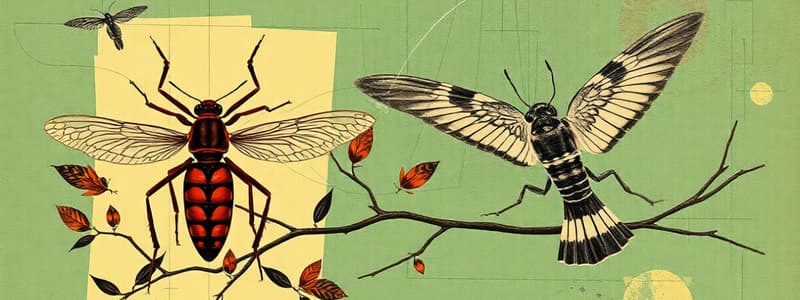Podcast
Questions and Answers
What is the process called when a nymph sheds its skin several times during development?
What is the process called when a nymph sheds its skin several times during development?
- Incubation
- Hatching
- Moulting (correct)
- Metamorphosis
What are the two layers found within a bird's egg?
What are the two layers found within a bird's egg?
- Embryo and nymph
- Yolk and albumen (correct)
- Shell and albumen
- Chalaza and shell
Which stage comes after the hatching of a bird from the egg?
Which stage comes after the hatching of a bird from the egg?
- Incubation
- Nymph
- Feeding (correct)
- Moulting
What is the term for the changes an insect undergoes from being a baby to an adult?
What is the term for the changes an insect undergoes from being a baby to an adult?
Why do birds sit on their eggs?
Why do birds sit on their eggs?
What characteristic is common to mammals?
What characteristic is common to mammals?
Which of the following animals is NOT classified as a mammal?
Which of the following animals is NOT classified as a mammal?
What is the role of the mother mammal after giving birth?
What is the role of the mother mammal after giving birth?
Which of the following are marsupials?
Which of the following are marsupials?
In some mammals, which parent may help care for the young?
In some mammals, which parent may help care for the young?
Flashcards are hidden until you start studying
Study Notes
Insects
- Insects reproduce by laying eggs.
- After hatching, baby insects undergo metamorphosis (changing of structure).
- Cockroaches and grasshoppers lay eggs that hatch into nymphs.
- Nymphs resemble adult insects but are smaller and lack wings.
- Nymphs undergo moulting (shedding their skin) several times during development.
Birds
- Birds reproduce by laying eggs.
- Eggs have a hard shell for protection. Inside the shell are albumen (white) and yolk (yellow).
- The yolk provides food for the growing embryo.
- The albumen protects the developing embryo.
- The chalaza holds the yolk in place.
- Birds incubate their eggs by sitting on them to keep them warm.
- After a period of incubation, the shell breaks, and the baby bird hatches.
- Newborn birds are often featherless and require feeding until they develop enough to fly and find food.
Life Cycle
- The various stages a living thing goes through from birth to adulthood is known as its life cycle.
Mammals
- Mammals give birth to live young.
- Mammals have hair or fur.
- Mammals produce milk to feed their young.
- Examples of mammals include dogs, cats, monkeys, tigers, cows, humans, whales, dolphins, and bats.
- Mammals care for their young after birth.
- Young mammals develop inside their mother's body.
- Mothers usually feed, clean, keep warm, and protect their young.
- Parents teach their young how to survive independently.
- Some mammals have pouches for carrying their young.
- These mammals are called marsupials.
- Examples of marsupials include kangaroos, koalas, wallabies, wombats, and opossums.
Marsupials
- Marsupials are mammals.
- Marsupials have a pouch.
- Mothers usually care for their young in the pouches.
Studying That Suits You
Use AI to generate personalized quizzes and flashcards to suit your learning preferences.




